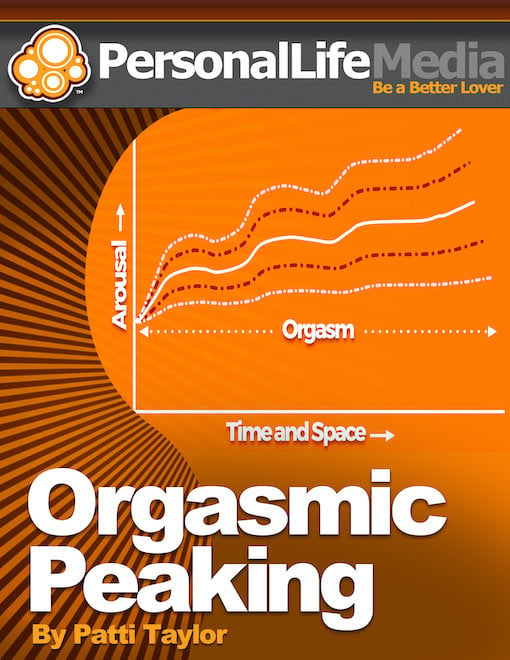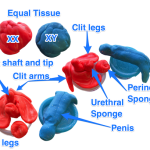Rob and Sally are learning about multiple, extended, and expanded pleasure Peaking.
She loves Rob’s sustained pleasurable attention, and—because Rob is allowing her more time to develop turn-on—he is noticing how much more aroused she is during lovemaking. He is getting pretty good at finding her “favorite spot” (covered in detail in the 21-Day Program) and staying on it longer.
He could tell how much she loved it! Yet now they had gotten to a plateau: Sally would climb and climb (way higher than she used to because Rob could stay in her favorite spot more)… but then, just as things were getting pleasurable, she would lose her concentration.
Her mind would wander and sometimes her genitals would even start to feel numb! Rob (being a lovingly attentive man) noticed this. He thought, “I guess I’d better intensify what I’m doing,” he’d stroke faster or harder to make up for what was happening with Sally. Sally found this irritating (not what she wanted), but she knew Rob was trying—and anyway, she too thought, “Yeah, maybe I need more intensity right now.”
The predictable result was that Sally started to drift and spiral downward. Sometimes, just to please both herself and Rob, Sally would “squeeze out” a petite orgasm (what we call a “go over a low edge”).
Sally correctly guessed that she needed more intensity but of a different kind. Now that Rob knew how to “find her” and take her up, she allowed herself to surrender to him more than she used to. In those new high arousal states, she needed him to be in more control of the “Peak Pleasure” energy as it developed. How could Rob do that?
Rob and Sally discovered the little-known but mighty secret to expanding and prolonging Peak Pleasure, allowing Rob to take Sally’s energy out there. At the same time, she surrendered more and more to her growing world of pleasure.
Have you ever had the experience of your partner’s pleasure and sensation climbing, climbing, climbing (I’m getting breathless just telling you this!), and then… pfft? The energy plateaus, drops, and maybe even evaporates. Then, when you try to “get it back,” you get two frustrated partners.
If this has happened to you (I’m playful—this has happened many times to everybody, including pleasure masters), you’ll be happy to learn about Peaking—the art of giving little intentional breaks or pauses of sensation during a sensual date. The art of peaking is easy to understand yet robust enough to yield new benefits for a lifetime.
Let’s say that during manual genital play, you give your partner a steady stream of genital sensations. You’ve found her favorite spot, you’re locked on to it, and you’re delivering just the perfect pressure, speed, and stroke. She is climbing with energy and enthusiasm. In short, she’s grooving to what you’re doing and where you’re taking her! And so are you!
So what happens if you don’t give her any pauses or intentional breaks? Are you touching, massaging, and soothing away, caught up in your pleasure of taking her higher and higher? At some point, she (as the energy receiver) will plateau, and—if you don’t catch what’s happening—you’ll start to lose her. Technically, she’ll find a way to end the sensation flow because it’ll be just too much.
Think of her “pleasure energy container” as a cup. You are filling her cup, and she loves that. You love that she loves it. So you keep filling her cup. Usually, once the pleasure climb starts, it accelerates. Pretty soon, her cup is complete, but you’re so enthusiastic that you just keep filling away. Now she’s overflowing; her cup can’t hold anymore. Biologically and energetically, she has to find some way to slow down the filling.
Here are some ways she might do this:
She can finish and go “over the edge” (and that edge might be a “low edge,” which could frustrate her if what she wants is more (longer, higher, more intense) of a Peak Pleasure experience.
She can find ways to create a diversion, such as wriggling her body, coughing, or asking you to slow down.
She can simply turn down her turn-on so that she feels less. If you’re lucky, this will result in her being able to continue to receive your input. If you’re not so fortunate, she might become numb. Uh-Oh! In my mentor, Dr. Patty’s book about Peak Pleasure, we’d rather not have our partner turn down her energy.
Instead, we’d manage the energy as the giver so that she constantly climbs higher measuredly. Think of yourself as helping her build a stable foundation so she can soar high.
Why would anyone try to end or lower the flow of pleasure? Simply put, our bodies can’t handle too much, too soon, of anything without a break. We need pauses to assimilate and distribute or (spread out) the pleasure. It’s no different from climbing a set of steps. We pause to catch our breath and gather our energy to climb higher.
That’s how peaking works. The intentional pause is so important because it allows the receiver to “catch her breath” and allow her to add her turn-ons! If done correctly, you’ll feel her “using” the break to feel more pleasure and her body reaching for that next pleasurable stretch.
If you’d like to know more about this Peaking technique, get Dr. Patti’s three free pleasure reports.

I need a LOT of peaking. Before Tim and I learned this technique from Dr. Patti, I had good intimate and sensual experiences. However, now that Tim “peaks” me, my orgasms climb to incredible heights of bliss. This simple technique could result in making your intimate experiences ten, even a hundred times better like it did for me.
All information from Susan Bratton, Personal Life Media, The20, and our collective brands are personal opinions. The statements made within this email/website have not been evaluated by the Food and Drug Administration. These statements and the products of this company are not intended to diagnose, treat, cure or prevent any disease. Always seek consultation from your doctor.








